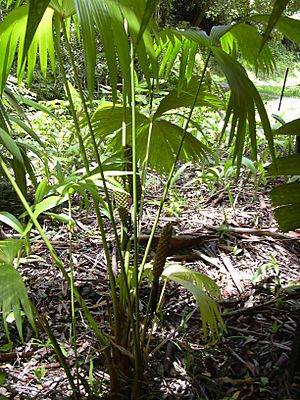Pandans facts for kids
Quick facts for kids Pandanales |
|
|---|---|
 |
|
| Carludovica palmata | |
| Scientific classification | |
| Kingdom: | |
| (unranked): | |
| (unranked): | |
| Order: |
Pandanales
|
| Families | |
|
See text |
|
Pandanales is a group of flowering plants. These plants grow mostly in tropical parts of the world. This means you can find them in warm, humid regions near the Equator. The order Pandanales includes many different kinds of plants. Some are tall, palm-like trees, while others are smaller shrubs. You can also find lianas, which are woody vines, and herbs, which are plants with soft stems.
Contents
What are Pandanales?
Pandanales is an order of plants. This is a way scientists group living things that are related. All plants in the Pandanales order share common features. They are all monocots. This means their seeds have only one seed leaf. Other monocots you might know include grasses, lilies, and palms.
Where do Pandanales Grow?
Most plants in the Pandanales order love warm weather. They grow naturally in tropical and subtropical areas. You can find them in places like Southeast Asia, Africa, and parts of the Americas. They often live in rainforests or coastal areas. Some types can even grow in swamps or along riverbanks.
Types of Plants in Pandanales
The Pandanales order has several different plant families. Each family has its own unique plants. Some of the most well-known families include:
- Pandanaceae: This family includes the famous Pandanus trees. They are often called screw pines because their leaves grow in a spiral pattern. These plants are very common in tropical coastal areas.
- Cyclanthaceae: These plants look a bit like palms. They are often found in the rainforests of Central and South America. A well-known plant from this family is Carludovica palmata, which is used to make Panama hats.
- Stemonaceae: This family includes herbs and climbing plants. They are mostly found in East and Southeast Asia. Some of these plants are used in traditional medicine.
- Triuridaceae: These are small, unusual plants. They often grow in dark, damp places on the forest floor. They get their food from fungi, not from sunlight.
- Velloziaceae: These plants are often found in dry, rocky areas in Africa. They can look like small trees or shrubs.
The Pandanaceae Family
The Pandanaceae family is one of the largest in this order. It includes two main groups: Pandanus and Freycinetia. Pandanus plants are trees or large shrubs. They have long, narrow leaves with spiny edges. Their roots often grow above the ground, like stilts. Freycinetia plants are usually climbing vines. They use other plants for support as they grow upwards. Both types of plants produce interesting fruits.
How Pandanales Reproduce
Like all flowering plants, Pandanales reproduce using flowers. Their flowers can be small and not very showy. Some plants in this order have separate male and female flowers. Pollen is often carried by wind or insects. After pollination, the flowers develop into fruits. These fruits can be very different depending on the plant. Some are large and woody, while others are smaller and fleshy. The seeds inside the fruits then grow into new plants.
Why are Pandanales Important?
Pandanales plants are important for many reasons.
- Food: The fruits and leaves of some Pandanus species are eaten in tropical regions. For example, Pandan leaves are used to flavor many dishes in Southeast Asian cooking.
- Materials: The leaves of Carludovica palmata (from the Cyclanthaceae family) are used to weave famous Panama hats. The strong fibers from Pandanus leaves are also used to make mats, baskets, and ropes.
- Ecology: These plants provide habitat and food for many animals. They also help prevent soil erosion, especially in coastal areas.
- Medicine: Some species are used in traditional medicine for various purposes.
Images for kids
-
Freycinetia arborea - a member of the Pandanaceae family
See also
 In Spanish: Pandanos para niños
In Spanish: Pandanos para niños



